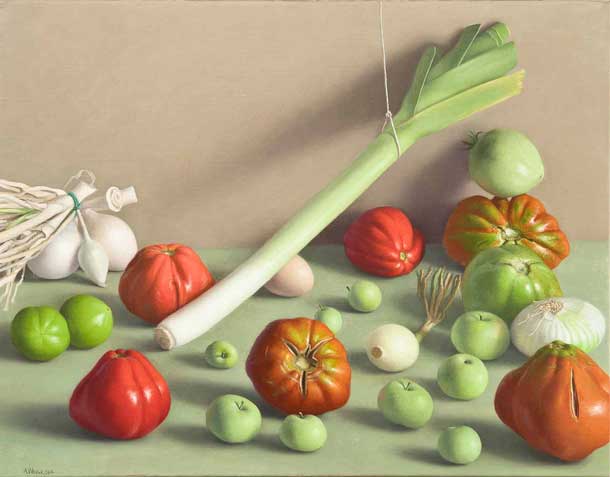
Amy Weiskopf “Still Life with Tomatoes, Green Apples and Leek“, 2010 Oil on linen, 13 3/4 x 17 3/4 in.
click here for a larger view
Images courtesy of the Hirschl & Adler Modern
Last summer I was fortunate to meet and study with Amy Weiskopf in Seina, Italy at the Jerusalem Studio School’s summer Certosa program. For the past several years Amy has spent her summers painting near Siena and living in New Orleans and New York City the rest of the year. I was thrilled when Amy agreed to an interview and that this post coincides with her current solo show at the Hirschl & Adler Modern Gallery in NYC September 8th – October 15th 2011.
Amy Weiskopf’s works are held in museum collections including the Arkansas Art Center and the Metropolitan Museum of Art in New York. Her work was shown in the Metropolitan Museum’s national traveling exhibition, Still Life : the Object in American Art, 1915-1995, Selections from the Metropolitan Museum of Art and the book of the same title. Weiskopf has been reviewed in Artnews, Arts Magazine, The New York Times, American Artist Magazine, and American Arts Quarterly, among others.The artist divides her time between New York, New Orleans, and Italy. She received her MFA at the Tyler School of Art (’83), Temple University, Philadelphia, PA
There is a delightfully humorous and thought provoking essay called Not So Fruit by Andrei Codrescu that was written in 1998 for her catalog for a show at the Hackett Freedman Gallery: Amy Weiskopf: Recent Paintings (1998) This essay can be read in it’s entirety from this link (not able to link directly so look for “Not so Fruit: Three Paintings by Amy Weiskopf, essay by Andrei Codrescu”)
Here is a brief quote from Andrei Codrescu’s essay:
“… An art critic would never mention such grossly political notions in the presence of Amy’s obviously formal universe. But herein lies one of the ironic pleasures of her art. While this painting clearly draws its spectator to the virtuosity of her brushes and to the painterly world that references itself without seeming concern for narrative, there are yet intentions that call for non-art-historical comment and stories. It’s not a guessing game either; like any serious art, this painting operates on several levels. To the specialist, it is a cornucopia: one can expand the whole range of a critical vocabulary on it. But to the outraged food critic and to the carnal spectator it represents an opportunity to throw fruit at the enemy. (The enemy is boredom.)”
from: “Not so Fruit: Three Paintings by Amy Weiskopf, essay by Andrei Codrescu”
Andrei Codrescu is a poet and writer. He is a Commentator on National Public Radio.
Larry Groff: What lead you to become a painter? What has been your biggest influence that lead you to become the painter you are today?
Amy Weiskopf:
It surprises me now that at a very young age I decided to be a painter. My father was an architect who also painted, my aunt is a painter and a close family friend was also painter. By 6 years old I had decided that’s what I wanted to be. During college it was the only time I briefly considered something else. I thought about majoring in history or art history.
My first biggest influence was my graduate studies at the Tyler School of Art with Bruno Civitico, an excellent painter and teacher who had studied with Gabriel Laderman in NYC. Through Bruno I learned about Laderman’s comprehensive way of looking at European figurative painting. My own work at that time was figurative but an eclectic mess and Bruno suggested I sit down and “look hard” at what I was painting. As soon as I began painting perceptually I was hooked. It was incredibly challenging but at the same time a relief; I had never enjoyed painting more.
My second major influence was going to Rome for my 2nd year of Grad school and then staying for nine years. I spent a lot of time studying European painting from antiquity to the 20th Century and this obviously had a huge influence on my work.
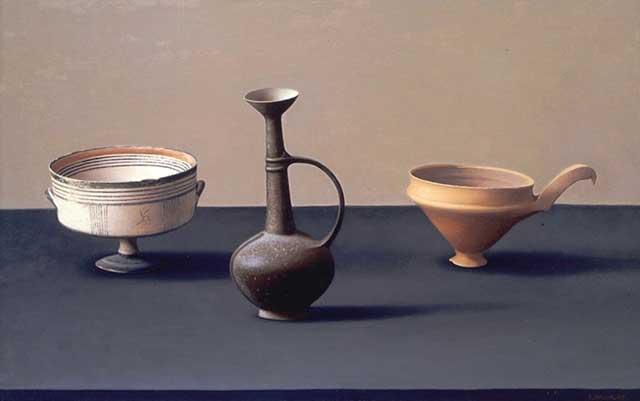
“Ancient Vases” 2006. Oil on linen, 10 x 16 in.
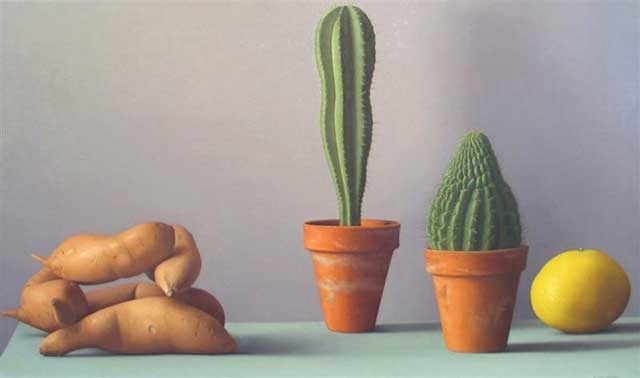
“Still Life with Sweet Potatoes and Cacti” 2006 Oil on linen, 14 x 24 in.
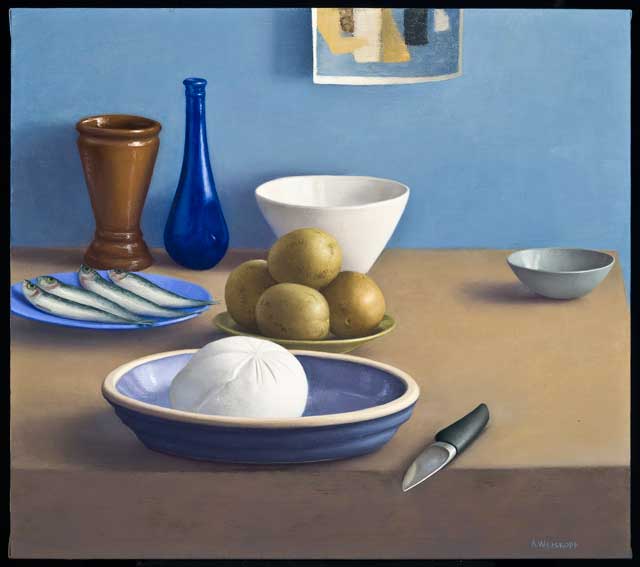
“Still Life with Mozzarella, Sardines and Knife”, 2011 Oil on linen, 16 x 18 in.
“Still life with Squash and Salami” 2000 13 1/4 x 18 inches Oil on linen
LG: In your slide talk at the Certosa last year you showed several absolutely stunning Italian landscapes however you currently paint mainly still life – Why do you prefer painting still-life?
AW: I like composing the set up more than I like finding it. I like the calm contemplative atmosphere of the studio. I work slowly and deliberately with the flux of nature, while an issue with still life, can be an overwhelming frustration for me in landscape painting. Also still life is a more intimate, more about looking inward than other genres. Traditionally, historical narrative painting was considered most important. Still life was the anti-heroic and the least important genre. The intimate and anti-heroic appeals to me and is much more suited to my psyche.
Having said that I should get back to painting landscape and I hope I do.
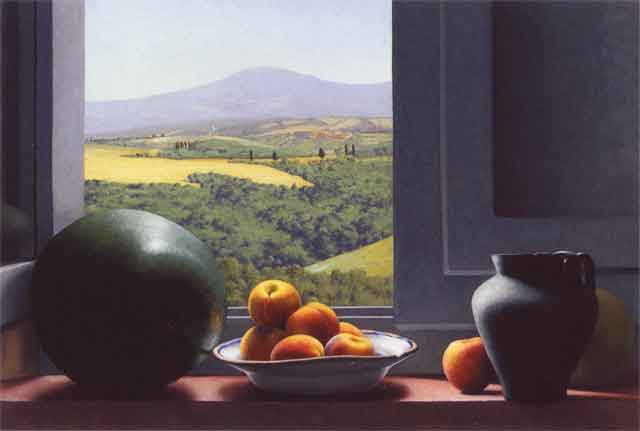
“Still life with Peaches and Melon” 1993 15 1/2 x 23 1/4 inches Oil on linen
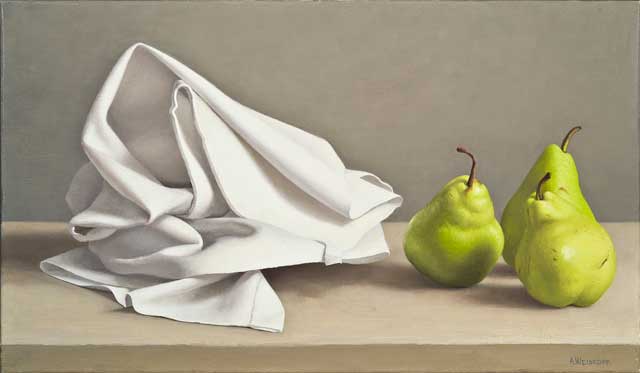
“Still Life with White Cloth and Pears”, 2010 Oil on linen, 9 1/2 x 16 1/4 in.
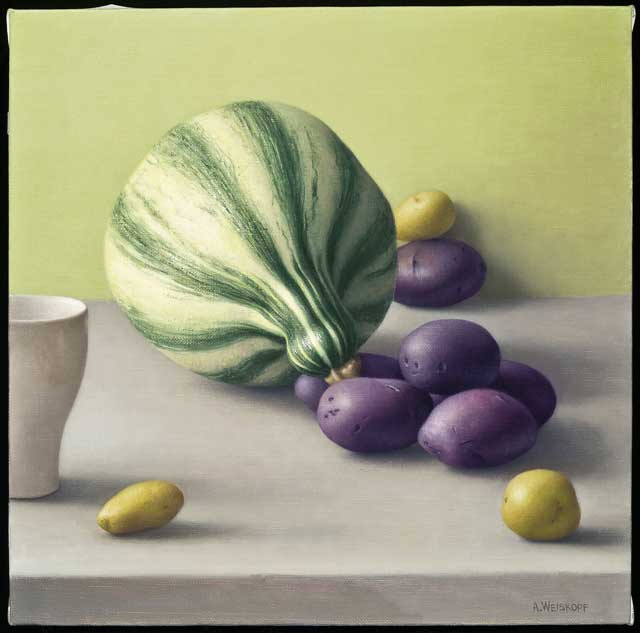
“Still Life with Cushaw Squash and Purple Potatoes”, 2011 Oil on linen, 12 x 12 in.
“Plums”, 2011 Oil on linen, 8 x 12 in.
LG: How long does it take you to set up your still life? Do you work out most of the formal issues before you start painting or is this something that evolves out of the process of interacting with the painting and looking at the setup?
AW: I can spend up to 3 or 4 days working out a set up for a larger painting. I usually have a vague idea but often head back to the vegetable stand half-way through the process. For smaller paintings it varies. I may take awhile to figure out a set up but sometimes I dump stuff on a table and realize that it cannot be improved on. I almost always like to ‘sleep on it’. I have learned the hard way that if I rush this process, painting is no fun. This is a very intuitive part and I often use something like Freudian free association to find both the subject matter and the arrangement for my still life’s.
I work out many formal issues regarding the composition in the subject onto the canvas and into the paint that the real decisions are made.
LG: Can you describe your painting process? Do you work directly or do you build the painting up with layers of glazes and scumbling? Anything interesting about your palette?
AW: First I make a rough sketch in charcoal. Very recently I started to do a pencil drawing first on paper if the subject is not too ephemeral. Next I block in the entire painting, always in one sitting and painting broadly. I scrape off most of the paint at the end of the first day but am left with a very clear image that hopefully establishes the tonality for the painting. After this I paint in thin layers slowly developing the color, form, space and detail. I do not glaze. I do some scumbling but mostly I paint directly using only turp as a medium. My palette is fairly typical, about 20 colors.
LG: There is a luminosity to your color as well as a fullness to your forms that is influenced by natural, indirect lighting in your still life setups. Can you speak about how you use light in your paintings?
AW: Finding studios with the right light is essential. I need two things: natural light and many hours of fairly consistent light. Natural light is more subtle, has a broader range and is more beautiful than artificial light. I need light that I find beautiful, or inspirational, light that moves me to paint. The light is inseparable from the color and I use it to create both the sense of form and space. I also look for light that is surprising and can flatten form and confuse space, ie. calls attention to the abstract qualities of a two-dimensional surface. I like it best when I can use light in all its capacities in a painting.
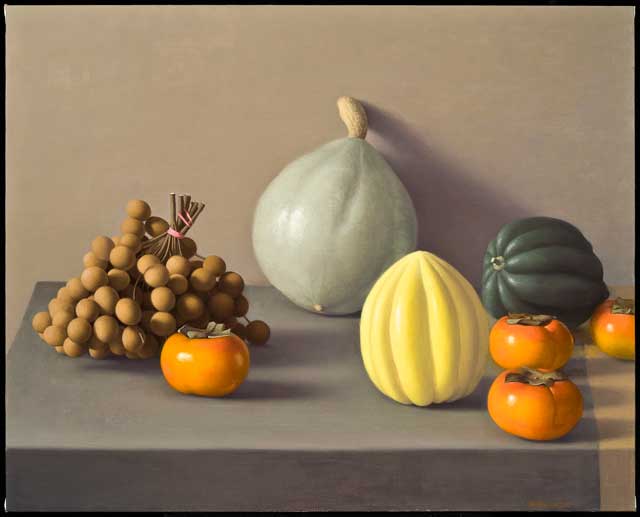
“Still Life with Longan Berry and Persimmons”, 2011 Oil on linen, 16 x 20 in.
LG: Your color is naturalistic but transcends mere description to create sophisticated color harmonies that seem to reference other art as well as the subject in front of you. What other influences for your color are there other than what you are looking at in the setup?
AW: I looked at a lot of baroque painting and had a darker palette which is one way of creating a sense of light. I love baroque still life’s but eventually the darker palette did not make sense. Now I use a lighter more tonal palette. Morandi is probably the best example of a modern tonal palette. A number of Italian figurative painters in the early 20th century learned lessons from modernism but looked back to pre-impressionist Italian painting and Corot for color. In Rome I discovered the Scuola Romana and was influenced by the kind of realism I saw in these paintings which blends traditional European painting (with Italian roots) and modernist ideas. Morandi and some painters in the Scuola Romana use color that I find beautiful and very interesting. They make full use of the relativity of color (in the Joseph Albers sense) painting with lots of subtle greys which contrast the less frequently used intense color. As I have said about light, color can be used to make space and form but it can simultaneously be used to contradict space and form and highlight abstract shapes. Using color in all of its complexity is what I find most interesting.
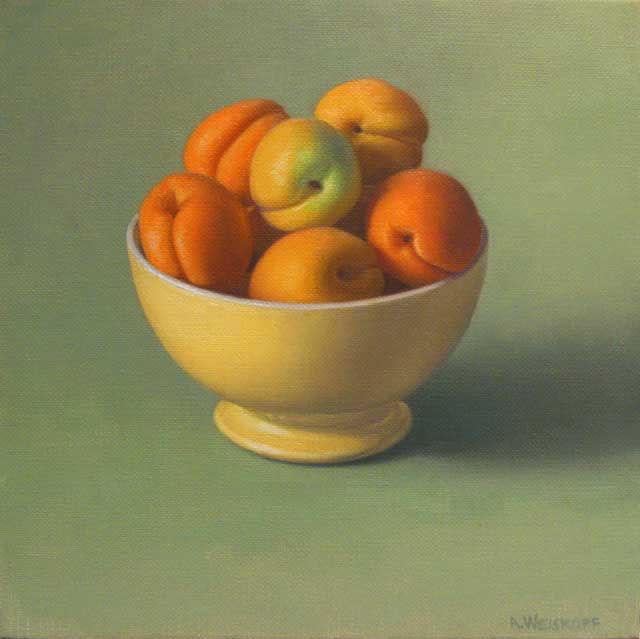
Apricots, 2011 Oil on linen, 8 x 8 in.
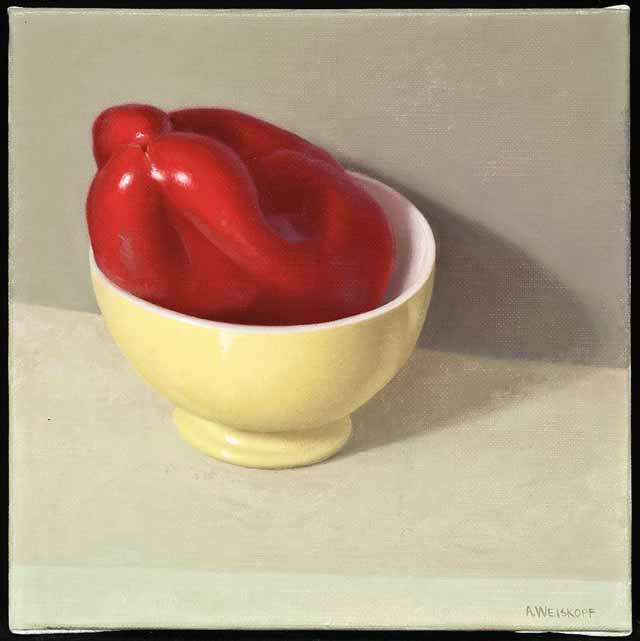
Red Pepper and Yellow Bowl, 2010 Oil on linen, 8 x 8 in.
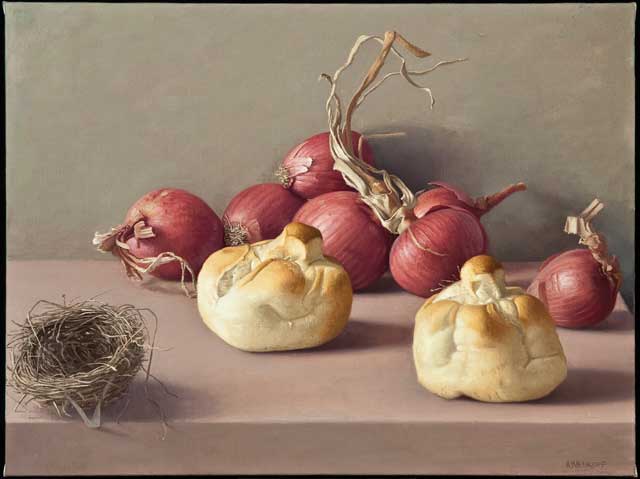
Still Life with Bread, Onions and Bird’s Nest, 2009 Oil on linen, 12 x 16 in.
LG: You eloquently spoke in an earlier artist’s statement:
“Today’s art world is wildly eclectic and every artist must make stylistic choices that indicate philosophical positions. I finished school in the early 80’s. At that time art tended to be more conceptual than visual. Sociopolitical issues outweighed aesthetics. Beauty, admittedly difficult to define, was considered elitist, trite, shallow, and inextricably tied to white European men. Pleasure, an equally slippery concept, was not discussed much. My reaction was to move to Italy where I spent the next 9 years looking at what those white European men, and a few women, had done.”
Call it the aesthetic experience, the pleasure created by a visual image, a nonverbal image, is particular and intense. In a personal and fairly empirical fashion I went looking for that experience, noticed when it happened, and tried to analyze why. For myself, the pleasure in looking is the fundamental force behind the power of visual arts. I believe painting can provide a particularly complex, therefore, pleasurable experience. This complexity is the result of highly orchestrated visual contrasts: spacial, tonal, chromatic and textural. I am a strict formalist; the structure of the painting creates the visual pleasure. I found still life the most suitable genre for organizing these effects. The sheer joy of looking at the painting, that visual and visceral understanding, so difficult to define, should never be eclipsed by more tangible considerations.”
LG: You strike many critical nerves here, such as how the Art world today frequently favors the conceptual over the visual or how Beauty and Pleasure seem irrelevant to much of contemporary art making. Could you elaborate further on this and particularly what you mean by your last point “The sheer joy of looking at the painting,…should never be eclipsed by more tangible considerations.”
AW: : I was referring to the fact that while painting can be analyzed in various ways- formally, socially, historically, politically, iconographically, and more. Its truest strength is NONVERBAL. Today it sometimes seems that people are uncomfortable with the ambiguity of a visual experience and want the reassurance of verbal ideas and explanations. Personally I think this is limiting. Exploring looking is much more rewarding and fun.
LG: How do you get to have such a wonderful life traveling, living and painting between New Orleans, the Siena region of central Italy and New York?
AW: Mostly luck being in the right place at the right time and clear priorities. I have always chosen having time to paint and living where I want over material possessions (I have none.)
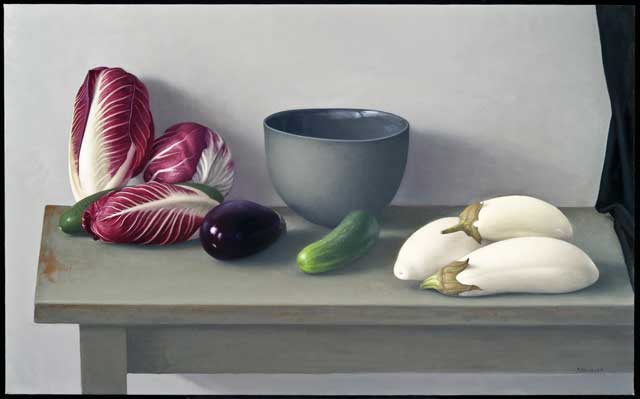
Still Life with White Eggplants and Radicchio, 2011 Oil on linen, 16 x 26 in.
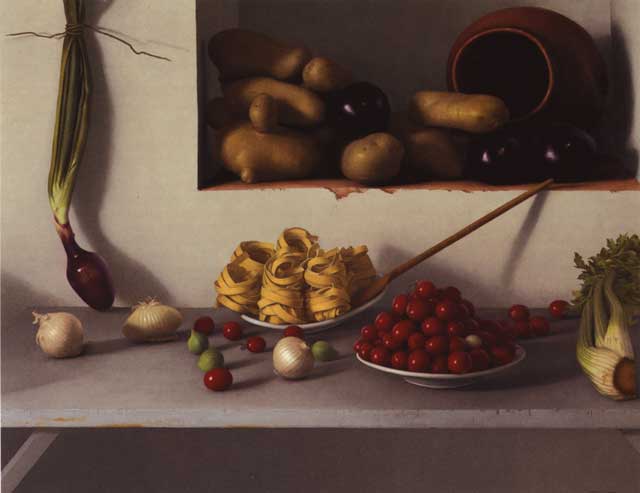
“Still life with Tomatoes, Tagliatelle and Potatoes” 2002 19 1/4 x 25 1/2 inches Oil on linen

“Figs, Fish, Bread and Bones” 2002 22 1/2 x 28 inches, Oil on linen

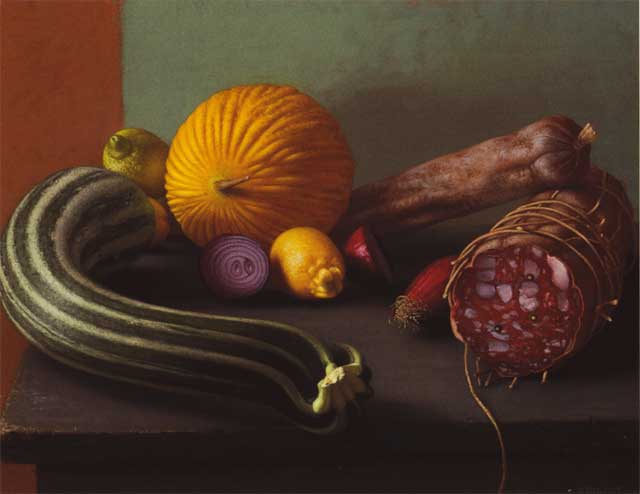
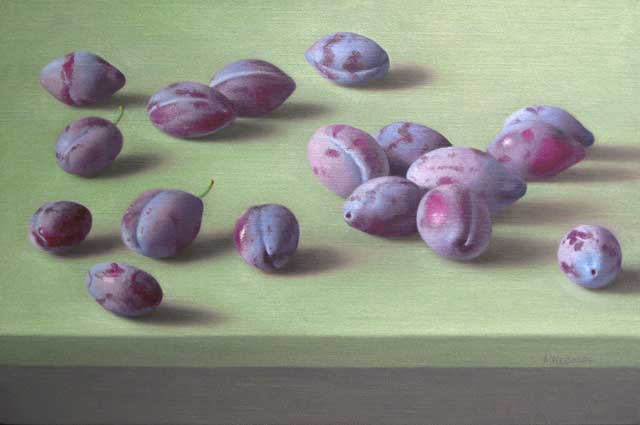




I agree with Amy that a painting’s truest strength is nonverbal. Her paintings are beautiful – wonderful spatial design.
Ms. Weiskopf you are a remarkable painter! Thank you for sharing your work and thoughts with us, and thank you Larry for another wonderful interview. I am reminded to be quiet and paint.
Thanks for this great interview Larry. I’m especially happy to see a range of Amy’s reproductions included because you can see how her approach to color has changed over time. For all of her “realism” Amy’s paintings are full of important formal and plastic lessons that many still-life painters seem to miss or avoid. Few people can achieve Amy’s level of realism while also referencing the flatness and contradictions that are also a part of our visual experience. Amy’s “charmed” existence, like her paintings, comes from an exceptional level of commitment and focus.
I’d describe these as “photographic” – not that they’re indistinguishable from photos, but in their composition, in the awareness of light detail and shape. Amazing.
Beautiful paintings Amy. Fond memories of Rome. Delighted to see your success!
I just discovered Amy Weiskopf’s paintings after wandering by the Clark Gallery in Lincoln, MA where there is currently an exhibit. I was seduced in by what I caught a glimpse of through the glass door. Once inside the gallery I was captivated by the preternatural quality of the paintings. I am a collector of beautiful objects—gem crystals, folk textiles, oriental rugs, found objects, ethnographic art, anything that is beautiful and all on the shoestring budget of someone who arranged his career to do what he liked doing (working with youth) and having plenty of free time. I’m looking forward to meeting Amy tomorrow at the reception for her at the Clark
Thank you for sharing your talent and hard work. It’s inspirational 😉 My partner is taking online courses at the ASL and told me to look at your work. Glad I did.